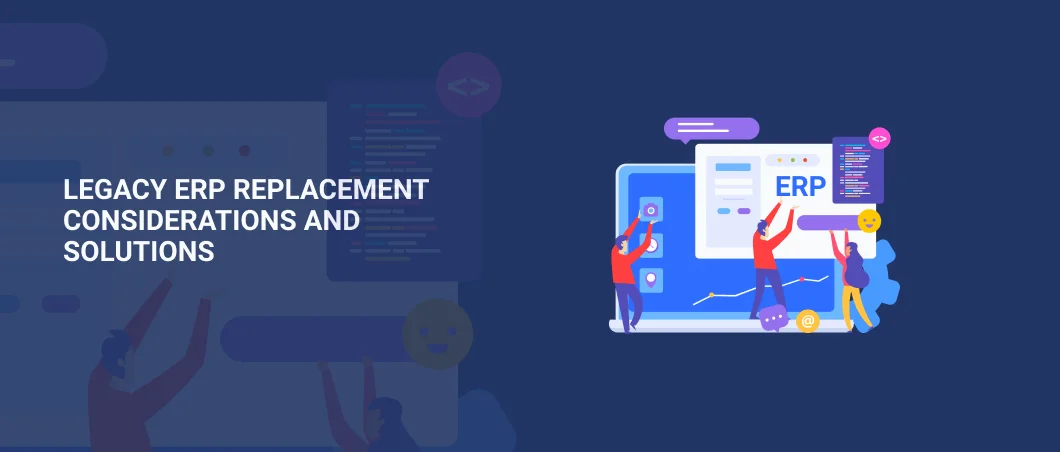 Enterprise resource planning systems have undergone several major face-lifts in the last two decades. When the term ERP was first introduced, the modern technological landscape could barely have been imagined. The whole interaction of businesses and individuals has changed dramatically.
Enterprise resource planning systems have undergone several major face-lifts in the last two decades. When the term ERP was first introduced, the modern technological landscape could barely have been imagined. The whole interaction of businesses and individuals has changed dramatically.
What this means for a business is that the tech they adopted as recently as five years ago may already be outdated and outclassed. A modern ERP solution 10 years ago could simply be junk-ware today.
Why Consider an ERP Replacement?
It can be easy to keep the status quo. If there is a gap in functionality, there are a multitude of suboptimal integration options. It is possible to keep a legacy solution going through patchworks and bandages. Your ERP can be stuck so many versions behind that you are “update-locked”. Unable to upgrade because of necessary third-party solutions, your aging ERP backbone becomes less sustainable by the day. This can wreak havoc on financial sustainability. That’s why you should consider the ERP replacement.
According to Forrester Research, an allocation of 50 – 90% of a typical IT budget is devoted to maintenance. If that same business is running a legacy system, expect that number to be much closer to 90. This means that innovation and development are all impeded as maintenance costs keep increasing to untenable levels.
Compounded with the issue of increasing costs is the steady decrease of the ability to make agile business decisions. With an antiquated ERP system, access to information is slowed. In today’s business landscape, information transfers must be seamless and in real-time. Without instant access to critical information, opportunities can be diminished and passed by.
The constantly shifting environment of modern-day communications and business can leave you stuck in quicksand if you choose to retain a legacy ERP.
Making a decision
The decision to either rip and replace or maintain is a difficult one. ERP replacements are disruptive and consume a significant amount of resources. The choice is not a tech one, but a decision supported by diligent business intelligence.
A cost-benefit analysis would be conducted. But ROI is not an equation involving solely financial capital. Factors run the range and include
• Improved customer service (which leads to higher retention)
• Increased sales rates
• Employee satisfaction and performance
• Enhanced business flexibility
• Better business-to-business relationships
It can be hard to convert these qualifying factors to calculable data points. It is also critical to run this analysis more than once. Factors and needs must adjust constantly as the business environment shifts.
What does the process of an ERP replacement look like?
One of the most critical fundamentals of going through an ERP replacement is scheduling and performing a “go-live” rehearsal. There are too many factors to list that can contribute to a system failure or dramatic slowdowns for the end-user. The mock day 1 deployment must have more than the normal amount of users (whether through real users or scripts) in order to simulate the eventual actual deployment.
Part of this process is forming a communication strategy with all of the stakeholders for your ERP solution. ERP change management is fundamentally about taking into account the interests of all of those stakeholders and aligning their goals.
This large group includes:
• Upper management (decision-makers)
• IT Department staff (implementers)
• Sales/marketing/operations/etc. team (the end-users)
• Customers
• Business partners
This is not a decision that can be reached in a vacuum. All those affected by an ERP system have to be considered. Only some will be directly involved in the process but a holistic view of the situation is crucial.
Future-proofing your Enterprise Resource Planning (ERP)
The ERP marketplace has widened and become more cluttered in the last decade. There are no longer just one or two big players who take the entire market share. There are mid-market and smaller options available. These are often quicker to implement and cheaper to purchase.
Truthfully there is no way of knowing whether an ERP solution could be future-proof. However, with the advent and increasingly widespread adoption of cloud computing, there certainly is well-founded hope.
Hosting providers like Amazon Web Services have made it possible to host some of the best ERPs on the market through the cloud. This makes it simpler to upgrade and integrate. What this means is that opting for a cloud solution can ensure that you should only have to go through a rip and replacement once.
Read More: Best ERP Software for the Manufacturing Industry (2021)

